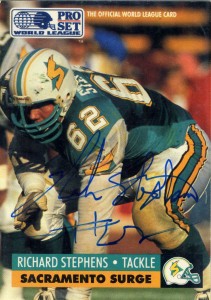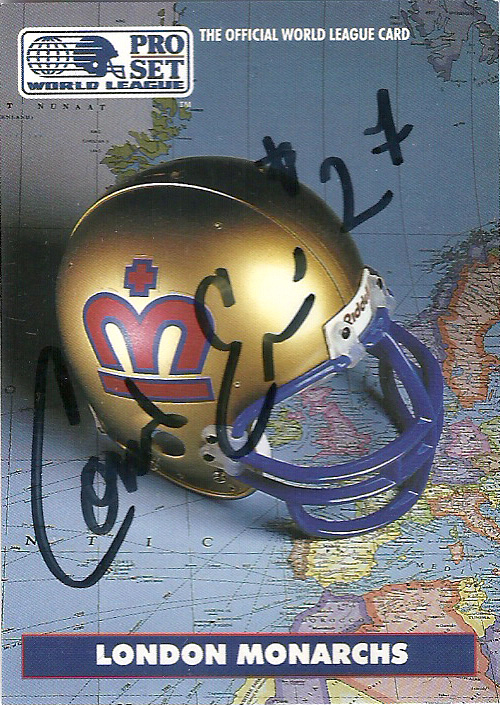
Coach: (1991) Larry Kennan, (1992) Ray Willsey
Stadium: Wembley Stadium
Record: (1991) 9-1* (1992) 2-7-1
*World Bowl Champions
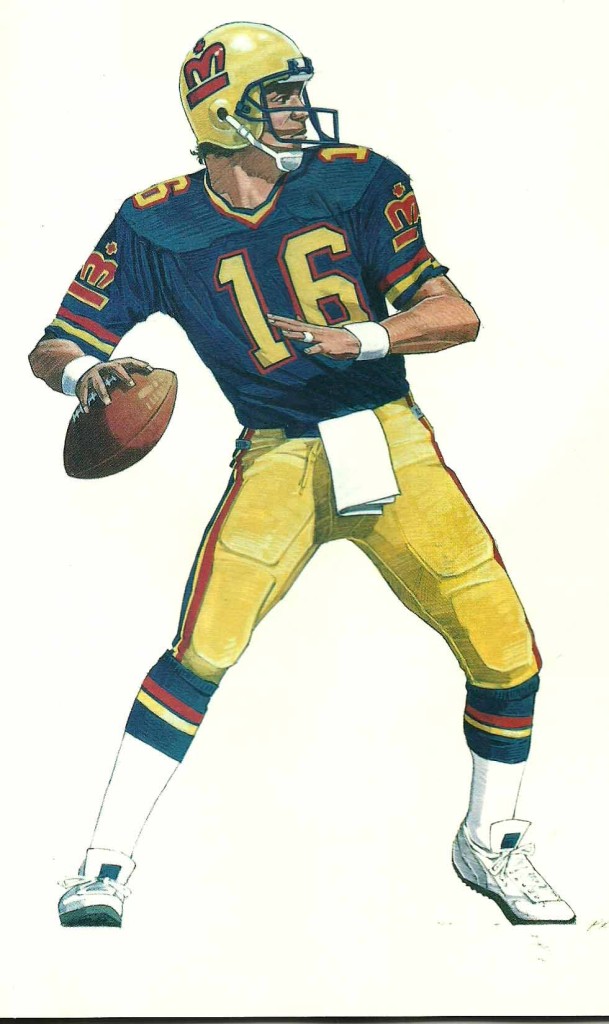
BACKGROUND:
London represents a pearl in the eye of the NFL that they have been eager to expand to internationally for quite some time. With the “London Bowl” and other experiments in checking the pulse of Englanders for their interest in American Football, the NFL made it official with their 1990 announcement that they intended to run an international league with a team in London.
Unable to find a suitor willing to cough up the 11 million dollar price tag to purchase the team, the Monarchs became a league run franchise. Led by league appointed general manager Billy Hicks, and English native and offensive head coach Larry Kennan, the Monarchs were the first team on the board taking defensive backs in the WLAF inaugural draft, and with that pick grabbed Corris Ervin. Through and through the Monarchs executed well in the draft, and it would show later in the All-World roster after the 1991 season, especially on the offensive line.
London later turned around and took Stan Gelbaugh in the WLAF supplemental draft to back up John Witkowski at quarterback.
London’s logo was an easy fit for the city, with the colors representing tradition, and the Union Jack, with an M in the shape of a crown.
The Monarchs were run on a shoestring budget and played in Wembley Stadium in downtown London. Like all European Stadiums, at capacity 87,000, the main purpose was for concerts and soccer games, but it was converted to handle the rigors of a 120+ yard stadium used in American Football games.
Footballs initially got stuck in customs and the limited number of footballs the team originally could get, became worn and flat after a few practices. The players quickly had to adapt to the open air stadium and wet Seattle-like weather of London. The Monarchs in the end however, put together an amazing run in 1991.
“We didn’t have any goalposts, so we used the film tower as our goalposts. We figured if we hit the video guy, the field goal was good.”
-Larry Kennan
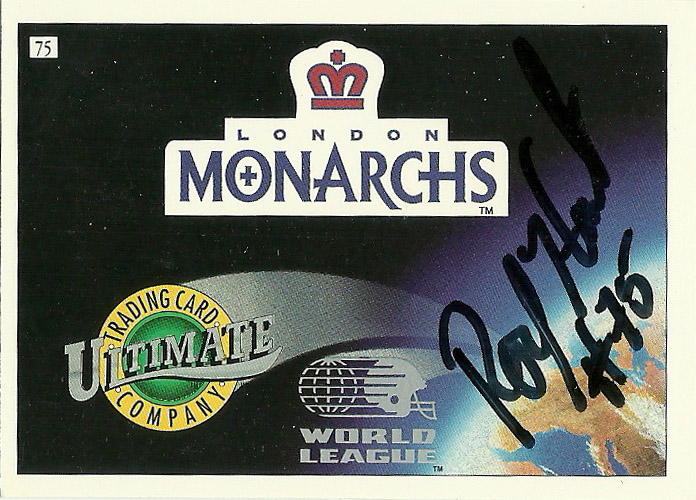
1991:
The first game in WLAF history would pit the Monarchs against the Frankfurt Galaxy. Chris Williams, (FRG) a nose tackle, scored the first points in league history when he stuffed runningback Judd Garrett (LON) for a safety. Starting quarterback John Witkowski was replaced in the lineup by Stan Gelbaugh, and the Monarchs high scoring offensive machine got on track in time to beat the Galaxy 24-11 in London.
Gelbaugh would not relinquish his role as starter for the remainder of his career on the team. In fact, he’d earn league MVP honors for his play at the end of the season.
At runningback the team sported sure handed receiver Judd Garrett, and hard nosed fullback Jeff Alexander.
The offensive line, which only allowed 11 sacks all season, was headlined by Doug Marrone, Steve Gabbard, Theo Adams, Paul Berardelli, and Larry Jones. Quality depth would be given from Todd Oberdorf and John Fruhmorgen. The line became known as ‘The Nasty Boyz’.
“It was an honor to play in Wembley Stadium. It was a great atmosphere. The fans were always into it. They knew when to cheer- when not to cheer- which was good. It was really just a good experience.”
– Judd Garrett
Monarchs RB
At wide receiver, it seemed no fair. The team drafted Dana Brinson and the league touted his dimunitive size and speed as electrifying for football in their print magazines. Brinson did not disappoint, leading the league in punt return yards. On the other side Jon Horton would lead all receivers in yardage, and dominate defensive backs week in and week out. They’d be backed up by veteran Tony Sargent, and Andre Riley.
Defense wasn’t an entirely different matter either on the “Hart Attack” defense. Roy Hart was one of the league’s dominating nose tackles in the Monarchs’ 3-4 defense. Linebacker Danny Lockett was the league leader sacks, along with Marlon Brown, while underrated Rickey Williams chipped in 70+ total tackles. At defensive back were Ervin, and headhunters Dedrick Dodge and Danny Crossman at safety.
Phil Alexander, kicker, and Victor Ebubedike, fullback, represented international flavor for the Monarchs, with the league’s “Operation Discovery”, and they too would be head and shoulders above their own international countrymen. Alexander led scorers his rookie season and was named Operation Discovery player of the year.
London lost their only game of the season in the final week versus their rivals, -the Barcelona Dragons. The Monarchs met them again in World Bowl I, suffocating the Dragons 21-0, paced by Judd Garrett with 13 receptions and Danny Crossman’s Herculaneum MVP performance with 3 picks and a touchdown. Slightly over 61,000 watched the game at Wembely Stadium in London. Afterwards the Monarchs were the toast of the town, even pressing a single titled “Yo Yo Monarchs!” Unfortunately this was the franchise’s only appearance in the World Bowl and the high point of the franchise.

“The entire UK has- just adopted us, and it feels so good. There’s not a man on that sideline that didn’t think that this was the biggest day of their life.”
-Skip Hicks
Monarchs GM 1991-1992

1992:
The Monarchs were picked apart by the NFL for talent in the offseason, and head coach Larry Kennan bolted for the states to become offensive coordinator of the Seahawks. To replace him, defensive coordinator Ray Willsey assumed the head coaching duties. London drafted Roland Smith (CB Miami) with their first pick in 1992, and later added notable names such as Bernard Ford (WR), and Steve McNair‘s older brother Fred, to back up Stan Gelbaugh at quarterback. Gelbaugh got embroiled in a league-wide contract controversy over league retainer fees, but was a true ironman, playing in the NFL during the WLAF offseason and then later returning to the lineup in 1992.
While the Monarchs started of with a shaky victory over their North American rival New York-New Jersey Knights, the team slumped losing 7 of their last 9 contests. Gelbaugh’s statistics notably dropped off from his MVP season as he threw for only 11 touchdowns to 12 picks.
On a brighter note, Jeff Alexander stepped up finishing the season with 702 rushing yards, and linebacker Danny Lockett had another outstanding season.
Outside of that, the Monarchs tied the Birmingham Fire-which ultimately proved pivotable in the American race between the Fire, Surge, and Riders. The WLAF reorganized after the 1992 season.
The Monarchs attendance dropped precipitously by over an average 19,000 from their inaugural season. (This dragged down mightily on the league’s overall attendance numbers, even though the bottom line was higher from the previous season for the WL.) It has been said that this was attributed to a perfect storm between the team’s poor 1992 showing and the team not being as generous with promotional and cheap seat tickets.
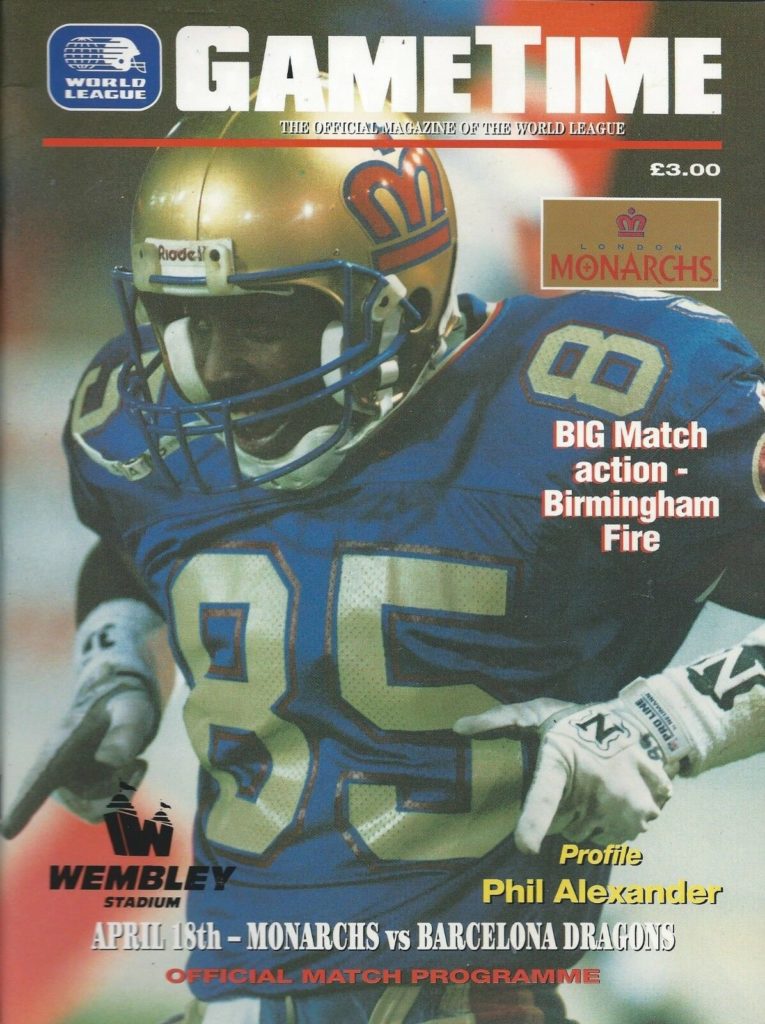
NOTES:
Future Raiders, Browns and Bengals assistant coach Hue Jackson served on the 1991 and 1992 staff of the London Monarchs.
World Bowl I recap:
http://www.youtube.com/watch?v=kInsYDY1l8I
Video Recap of Monarchs 1991 season:
http://www.youtube.com/watch?v=MopRjcXpkyg&feature=related
LEGACY:
The Monarchs (along with the Dragons and Galaxy) were reborn in the reconstituted NFLE in 1995, and their games moved to White Hart Lane. With the Monarchs reconstituted, London came out flat under head coach Bobby Hammond, posting three 4-6 records in a row. Fan attendance began to dwindle.
The NFLE rebranded the team as the England Monarchs, hired Lionel Taylor as head coach, and took the team on the road at home to play in a variety of venues including the Crystal Palace, Ashton Gate, and Alexander Stadium. This clever promotion wouldn’t save the franchise, and at the end of the 1998 season, the franchise was shut down after a 3-7 record and even worse attendance than at White Hart Lane.
Victor X Ebubedike, would be the lone holdover from the original roster seeing it from beginning to end. Other notables along the way to play for the Monarchs included, future Superbowl quarterback Brad Johnson and former Chicago Bears star William “The Refrigerator” Perry.
The London Bowl has continued since the NFLE folded and the NFL has continued to express an interest in fielding a team internationally starting with London. The Jacksonville Jaguars have also played regular season ‘home’ games there from time to time, fueling speculation of the team’s departure to the other side of the pond.
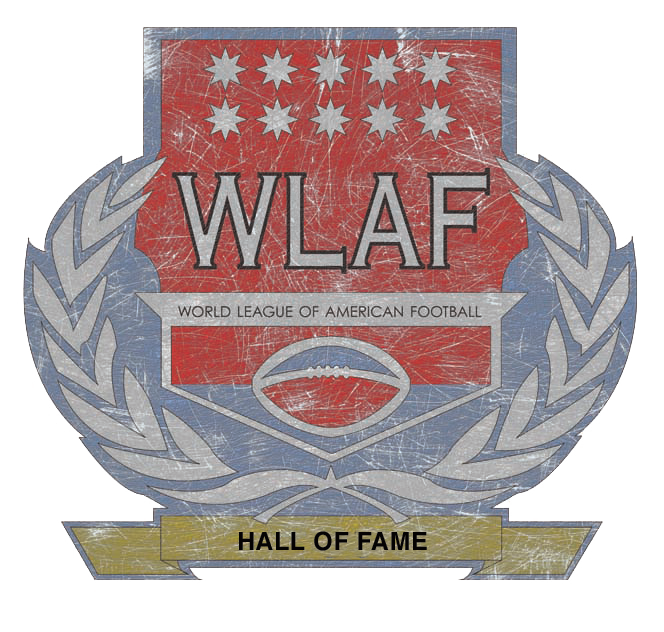
HC- Larry Kennan
Other Coaches- Hue Jackson
QB- Stan Gelbaugh, John Witkowski, Fred McNair
RB- Jeff Alexander, Judd Garrett, Charlie Young, Victor Ebubedike, David Smith
WR- Andre Riley, Dana Brinson
OL- Steve Gabbard, Paul Berardelli, Doug Marrone, Theo Adams
DL- Roy Hart
LB- Rickey Williams, William Kirksey,Ricky Shaw, Marlon Brown, Dannie Lockett
DB- Dan Crossman, Corris Ervin, Dedrick Dodge, Irvin Smith, Howard Feggins, Harvey Wilson, Roland Smith
K- Philip Alexander
P- Greg Horne
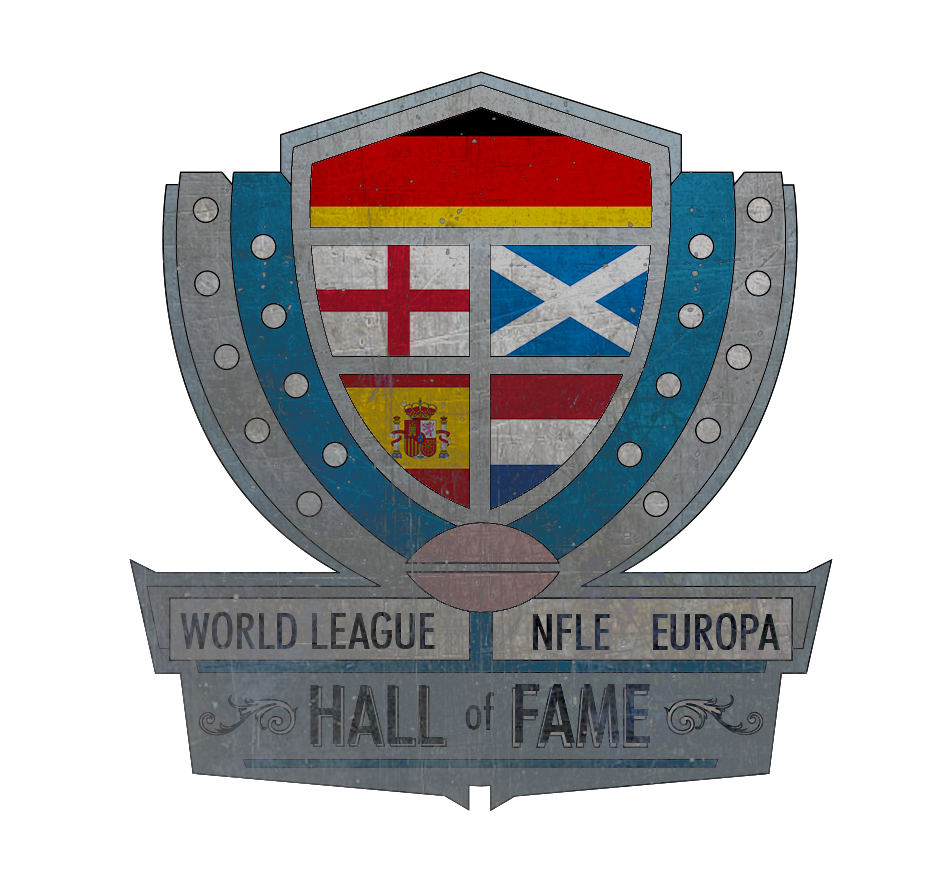
Other Coaches- Lionel Taylor
QB- Brad Johnson, Charles Puleri
RB- Gaston Green
TE- Michael Titley
DL- William Perry
K– Roger Ruzek
At this time I am still missing autographs on these cards from:
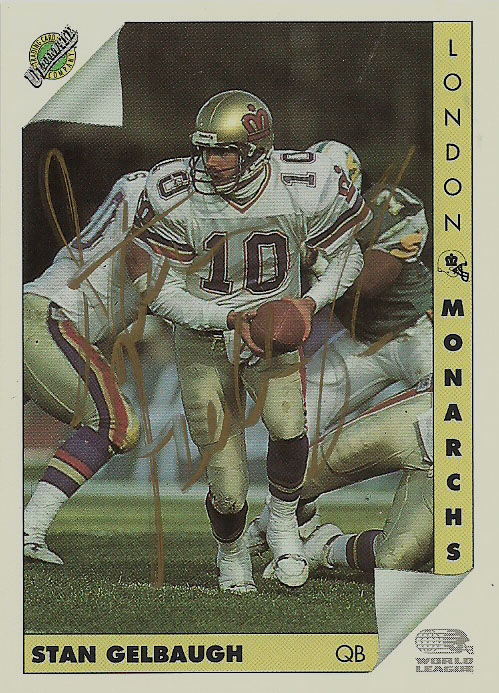
Proset WLAF 1991:
Jon Horton
Ken Sale
Wild Card WLAF 1992:
Tony Sargent
Curtis Moore
Bernard Ford
Sean Foster
Ultimate WLAF 1992:
Jon Horton
David Smith

